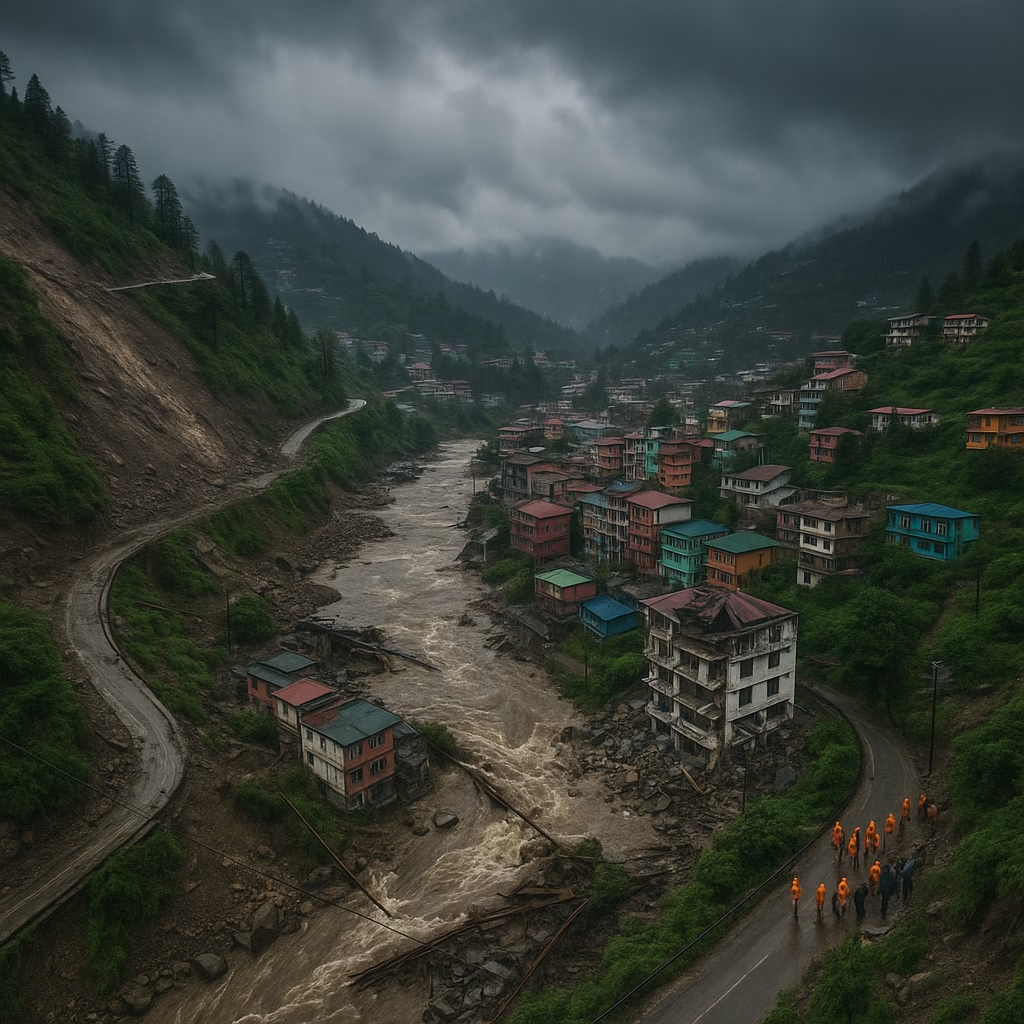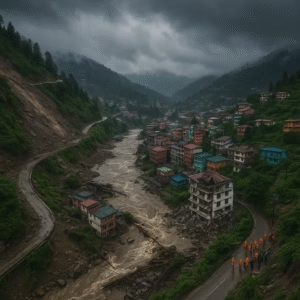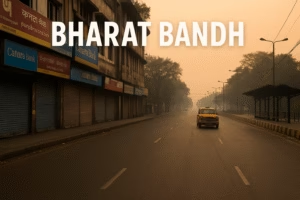
monsoon havoc Himachal Uttarakhand
Monsoon Havoc Himachal Uttarakhand: Buildings Collapse, Roads Washed Out

With the early arrival of the 2025 southwest monsoon, the picturesque hills of Himachal Pradesh and Uttarakhand have turned into zones of devastation. From collapsing buildings in Shimla to halted pilgrimages in Uttarakhand, the fury of nature is laying bare the fragile state of infrastructure in India’s northern hill states. What began as a season of much-needed rain quickly spiraled into a humanitarian and ecological crisis.
The Collapse in Shimla: Warning Signs Ignored
In Shimla’s Mathu Colony, a five-storey building collapsed like a deck of cards, though fortunately, no lives were lost due to timely evacuation. Cracks had appeared in the structure months ago, believed to be a direct result of nearby road widening activity. Despite repeated complaints, no meaningful stabilization work was undertaken, turning a vulnerable building into a disaster waiting to happen.
Experts now point to the dangers of rapid urban development without environmental foresight. A geotechnical survey had reportedly flagged the area for its risk, but commercial expansion won over caution. The incident mirrors countless other warnings across Himachal’s urban zones, where tourism and infrastructure growth often outpace safety regulations.
Roads Blocked, Towns Cut Off
As heavy rainfall continued over several days, more than 130 roads across the state became inaccessible. Key highways, including the vital Chandigarh–Shimla route and parts of the Kalka–Shimla heritage rail line, were shut down due to landslides. In remote areas like Mandi, Chamba, and Solan, residents were left without electricity, water supply, or communication as mudslides swept through fragile slopes.
The Beas River, swollen with rainfall, surged over its banks in Kullu district, washing away vehicles, livestock, and homes. Emergency crews faced enormous challenges accessing the areas, with local police and the State Disaster Response Force working around the clock to reopen roads and restore basic services.
Uttarakhand: Sacred Routes Under Siege
Uttarakhand, too, is in crisis. The famous Char Dham Yatra had to be halted following multiple cloudbursts and landslides along pilgrimage routes. In a tragic incident near Rudraprayag, a bus carrying pilgrims skidded off the road and plunged into the Alaknanda River, resulting in five deaths and several missing.
In Uttarkashi, a cloudburst wiped out a laborers’ campsite, leaving at least two dead and several others missing. The relentless rainfall has made rescue efforts extremely dangerous, with many areas rendered inaccessible even by helicopter.
Death Toll and Red Alerts
As per official figures released on June 30, 2025, Uttarakhand has recorded at least 65 deaths in June alone, including those caused by road accidents linked to poor visibility and slippery terrain. Himachal has not yet confirmed a toll, but officials warn that worsening weather could quickly escalate the situation.
The India Meteorological Department (IMD) has issued red alerts for several districts in both states, warning of extreme rainfall, flash floods, and landslides through the first week of July. Schools in Dehradun and other regions have been shut, and tourists are being advised to stay away.
The Human Impact: Isolation and Displacement
Beyond the headlines, the real suffering is playing out in hill villages now cut off from the rest of the world. Families are cooking over open fires with dwindling supplies, children are unable to reach schools, and hospitals are operating in emergency mode. In Saraj and Janjheli regions, 38 roads have been rendered impassable, and emergency electricity poles are being flown in.
With no clean water supply, a secondary crisis looms — the outbreak of waterborne diseases. Relief camps have been set up by local governments, but their reach is limited by geography and weather conditions. NGOs like Goonj and SEEDS India have begun mobilizing volunteers to supply essential items.
How Did It Get This Bad?
Experts argue that the devastation is not merely a result of nature’s fury but of human negligence. Reckless road-widening projects, deforestation, illegal construction on hill slopes, and failure to follow geological surveys have all contributed to the collapse.
Both Himachal and Uttarakhand have witnessed rapid urbanization over the last decade. From resorts mushrooming in ecologically sensitive zones to road projects cutting into stable hillsides, the Himalayas have been exploited beyond sustainability. The monsoon, intense as it is, merely exposed these cracks.
Calls for Structural Change
Following the chaos, environmentalists and civil engineers are urging the central and state governments to impose stricter controls on development in ecologically sensitive zones. There are growing calls for:
- Mandatory geo-technical audits before any construction
- Real-time weather monitoring and warning systems in hill districts
- Ban on unplanned expansion in vulnerable areas
- Restoration of natural drainage and vegetation
The National Disaster Management Authority (NDMA) has also emphasized the need to deploy advanced AI and drone-based assessments to identify high-risk zones in real time.
What Lies Ahead?
The monsoon season is just beginning. With more rains forecasted in July and August, authorities must prepare not just for relief but also for prevention. Rescue operations are ongoing, but rebuilding trust and infrastructure will take years, not months.
The hill states are at a tipping point. Either India prioritizes ecological safety and sustainable development, or it risks turning its paradise into a perpetual disaster zone.
As we watch these scenic hills fight for survival, the rest of India must recognize the storm as a warning. Development without foresight is destruction in disguise.
Want to track rainfall patterns and landslide-prone zones? Visit this Times of India report.
Check out for latest news!
About The Author
Discover more from Trendy India News
Subscribe to get the latest posts sent to your email.






